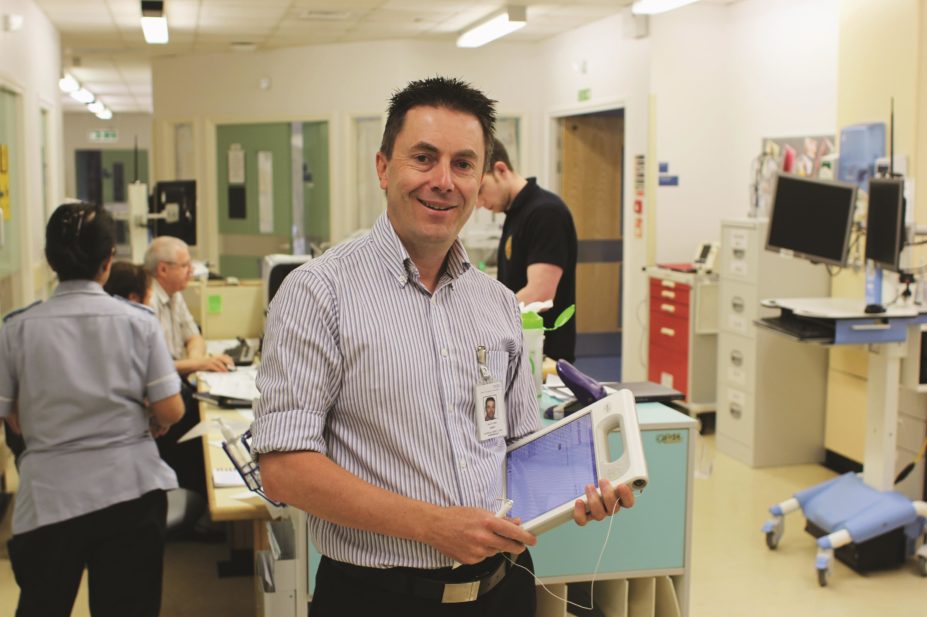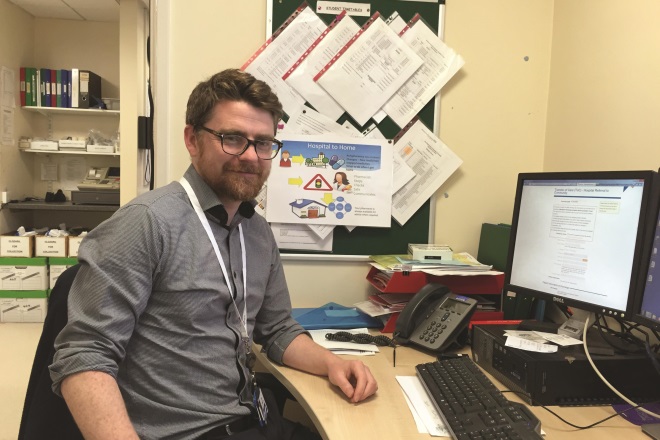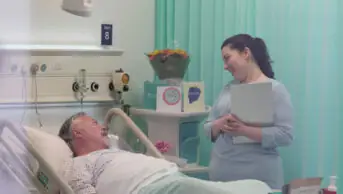
Courtesy of East Lancashire Hospitals NHS Trust (ELHT)
When Derek Smith, a patient with type 2 diabetes, was discharged from hospital after a mitral valve replacement, he started to experience hypoglycaemic episodes. Smith’s oral hypoglycaemic drugs had been changed while he was in hospital and insulin treatment started. A follow-up appointment with a diabetologist to review his insulin treatment had been arranged for ten days after his discharge but, before the diabetologist had seen Smith (whose name has been changed) and unbeknown to his carers within the hospital system, the hypoglycaemic episodes were causing him to fall.
Fortunately for Smith, explains Steven Brice, assistant director of pharmacy at Newcastle upon Tyne Hospitals NHS Foundation Trust, a hospital to community pharmacy referral system at the trust alerted his community pharmacist to the changes in his treatment. Knowing that the patient’s wife looked after his medicines and that he might not have understood the changes made in the hospital, the pharmacist arranged to see the patient together with his wife four days after his discharge. During the consultation, the pharmacist recognised that Smith was experiencing hypoglycaemic episodes, including dizziness and falls, and provided advice to ensure Smith’s safety.
“Had the pharmacy referral system not been in operation, Smith could have suffered significant harm as a result of hypoglycaemia and/or been readmitted to hospital,” says Brice, who together with director of pharmacy Neil Watson set up the transfer of care initiative. “It would have been more difficult for the community pharmacist to help – she would have been unaware that Derek had just been discharged from hospital with changed medicines and therefore would have been unable to help in a timely way.”

Source: Courtesy of Steven Brice
Patients appreciate the transfer of care between hospital and community pharmacy, says Steven Brice, assistant director of pharmacy at Newcastle upon Tyne Hospitals NHS Foundation Trust
Stories like this, says Brice, underline the value of a scheme designed to ensure accurate transfer of information about discharge medication. At least two such systems are in operation in England, with others in Wales and Scotland.
Need to know
Internationally, an understanding of the need for systems to ensure accurate transfer of medicines information at the interface of care has grown steadily over the past ten years. Arguably, the first steps were taken by hospital-based pharmacists who recognised the need to take accurate drug histories when patients were admitted to hospital and developed systems to gather all the information from GP and community pharmacy records, and sometimes from the patient’s carers.
Studies showed that drug histories taken by pharmacists contained fewer discrepancies than those recorded by junior doctors and therefore formed a better basis for decision-making[1]
. Much of this work was done in the 1990s and became embedded over the next few years when the term ‘medicines reconciliation’ was introduced[2]
.
In the past, we just dispensed the discharge medicines but now we are identifying the support that patients will need with medicines when they leave hospital
But it took time to develop a service that improved medicines management at discharge. Anecdotes about patients returning home and restarting the medicines that got them into hospital in the first place or double-dosing because they had two packets of tablets that looked different but had the same active ingredient were frequently cited[3]
.
“In the past, we just dispensed the discharge medicines but now we are identifying the support that patients will need with medicines when they leave hospital,” says Brice. “This is changing the way that the hospital pharmacy works.”
Different approaches
In December 2014, the Innovators’ Forum at the Royal Pharmaceutical Society (which publishes The Pharmaceutical Journal) published ‘Hospital referral to community pharmacy — a toolkit for commissioners’[3]
. The 21-page document was largely based on the experiences of the Refer-to-Pharmacy (R2P) scheme in East Lancashire. Both R2P and the Newcastle project rely on electronic transfer of information from hospital to community pharmacists and both have received national awards from the Health Service Journal, underlining the fact that their value is recognised beyond pharmacy. Other schemes are in operation elsewhere in the UK, meaning that there is, as yet, no uniform national system to manage the transfer of care of NHS patients.
The transfer of care initiative in the North East is built on the PharmOutcomes software, originally designed to support the collection of information about community pharmacy activity. “It was a light-bulb moment when we realised that PharmOutcomes was already in place in all community pharmacies and was web-based,” says Brice. “So we worked with Pinnacle Health (the software developers) to develop a template that could be used to transfer discharge information to community pharmacists.”
Since it is web-based, the form can be completed from anywhere that has internet access and it takes a hospital pharmacist or technician two minutes to complete.
Community pharmacists receive an email to notify them of a referral and log in securely to view the details. The community pharmacist can then contact the patient to arrange follow up, with records made of the action taken. PharmOutcomes software is available to all community pharmacists – local pharmaceutical committees or local authorities often hold the licences.
In East Lancashire, the R2P electronic referral scheme uses purpose-built software to refer patients directly to community pharmacists when they are discharged from hospital. Community pharmacists receive an encrypted copy of the discharge summary letter together with a referral note listing the pharmacy service recommended, for example a post-discharge medicines use review (MUR).
R2P has been developed locally through a partnership between East Lancashire Hospitals NHS Trust (ELHT) and Webstar-Health. The system is available to purchase by paying a licence fee to cover systems support. In East Lancashire this cost is funded by the hospital and two clinical commissioning groups; there is no charge to community pharmacies. “Everything we have done has been driven by the desire for simplicity, user-friendliness and ease of use,” says Alistair Gray, clinical services lead pharmacist, ELHT. “R2P is integrated with the trust’s IT system and requires only a few clicks to create and complete a referral. Patient information is pulled automatically from the patient administration system (PAS) and referral details are largely menu-driven.”
Patients are invited to give their consent and are shown a short film on the bedside television to explain the scheme. Consent information is available in English and eight other languages.
“Another feature is ‘hospital admission notification’ messages — for example, when a patient is admitted who is using a monitored dose system (MDS) or is a care home resident, the pharmacy can be asked to pause dispensing until further notice — potentially saving time and avoiding wastage of medicines,” says Gray.
The process closes a risk loophole for the occasional patient who is discharged and whose GP would never otherwise receive a discharge letter
Once the R2P referral has been prepared, it is automatically sent only when the patient is discharged and the discharge letter has been completed. If a patient is discharged without a summary letter, an alert is generated. “This closes a risk loophole for the occasional patient who is discharged and whose GP would never otherwise receive a discharge letter,” says Gray.
Community pharmacists receive notifications by email, fax or text and then log in securely to accept or reject the referral and to access the clinical information.
In Scotland, several transfer of care projects are operating. A scheme in NHS Forth Valley allows hospital pharmacists to send electronic admission notifications and pharmacy care plan reports (PCPRs) to community pharmacists. The PCPR includes a list of new medications, details of discontinued items and information on any allergies. Relevant clinical information can also be added. The messages are received in the Pharmacy Care Record, a secure, web-based tool used in all community pharmacies in Scotland.
Like the R2P scheme in East Lancashire, the Forth Valley referral system can notify community pharmacists when one of their patients is admitted to hospital. “[This] makes a big difference to community pharmacists,” says Fiona Stewart, lead pharmacist for primary and community care, Forth Valley. “They can quarantine any previously dispensed medicines awaiting collection and are then aware that there could be changes to a patient’s medicines when they leave hospital.”
Community pharmacists use the PCPR to perform a medicines’ reconciliation after patients are discharged from hospital. “We have picked up discrepancies,” says Stewart. “[For example,] a newly discharged patient tried to order an item that had been discontinued in hospital. The pharmacist was able to intervene and it transpired that the patient was hard of hearing and had not heard or understood what they had been told at discharge and did not realise the item had been changed. Their community pharmacist, however, was able to explain because of the information in the PCPR,” she adds.
A national approach
In Wales, the discharge medicines review (DMR) service has been operational since November 2011. It is an advanced service under the community pharmacy contract and can be provided in the pharmacy, by phone or in the patient’s home. With the patient’s consent, it can also be conducted with a carer. Originally established as a paper-based system, an electronic version (eDMR) was launched in March 2015, although it is not working in all pharmacies yet. The system relies on a national software package (Choose Pharmacy) that connects all community pharmacists with secondary care. At the point of discharge from hospital, an electronic alert is sent to the patient’s nominated community pharmacy. The community pharmacist can then log in to obtain the discharge advice letter (DAL), which contains the discharge medication list and details of discontinued medicines.
The paper system worked well but patients don’t always remember to take the letters to the pharmacy — the electronic system ensures that the information arrives
“The paper system worked well but patients don’t always remember to take the letters to the pharmacy — the electronic system ensures that the information arrives,” says Judy Henley, director of contractor services at Community Pharmacy Wales, the body that negotiates the contractual terms for the provision of NHS community pharmacy services.
“Integrating services in this way is changing the roles of pharmacists — they understand each other’s role and are more ready to contact each other to discuss patients. Pharmacists in hospital… feel reassured that [patients] will get the necessary follow-up and support with their treatment.”
Positive outcomes
One pharmacist using the R2P system is clear about the benefits.
“There is no question — it saves time for us,” says Mark Collins, an independent community pharmacist in Nelson, Lancashire, who is linked up to the R2P system. “We get the same information as the GP in a timely manner. It tells us what is needed and we don’t waste time contacting the hospital or the GP to chase the discharge information.”

Source: Courtesy of Mark Collins
Mark Collins, an independent community pharmacist in Nelson, Lancashire, is linked up to the R2P system, which he says provides the information he needs in a timely manner
Collins cites a recent example when a patient with rheumatoid arthritis and several other conditions was admitted to hospital. “A lot of changes were made to her medicines and her husband, who deals with her medicines, was confused about the changes. We were able to explain the changes to him in an informed way — previously we would not have had the information to hand,” adds Collins.
The R2P system saves time for community and hospital pharmacists alike.
“In as little as 11 seconds we can provide the community pharmacist with incredibly rich information, whereas previously we have phoned them, taking several minutes,” says Gray.
The referral process “often opened up discussion about medicines”, adds Jane Ferguson, a research associate at the University of Manchester, who is involved in evaluation of R2P. And patients who have been referred via the system are visiting the pharmacy more frequently now to ask about medicines, she says.
Both English schemes are now being rolled out. “The [PharmOutcomes] scheme started in Newcastle in July 2014 but is now being used across the North East of England and North Cumbria,” says Brice. “There are now nine hospital trusts that are able to refer to some 600 pharmacies.” The bulk of completed episodes relate to patients with cardiovascular or respiratory disease, and data, as yet unpublished, suggest that patients receiving a follow-up referral are less likely to be readmitted to hospital.
For the R2P scheme, all the pharmacies in the local health economy (around 150) are participating. Current estimates suggest that each pharmacy receives between one and three referrals each week.
The R2P scheme has been fully operational since November 2015. Between 1 January 2016 and 21 July 2016, 2,649 referrals have been made. Most referrals (1,056) related to changes to blister-packed medicines for MDSs, while a further 988 referrals were to recommend a post-discharge MUR or new medicine service consultation. The remaining 584 referrals were related to changes to medicines for care home residents and miscellaneous information, with a further 21 referred to the home visit teams since the end of June 2016. Over this period, there were 80 fewer readmissions (at 28 days with the same diagnosis) compared with the same period in 2015 — a reduction from 4.2% to 3.2% — raising the possibility that the linking of pharmacy services and information in this way is helping to prevent medication-related readmissions.
We have calculated that we would only need to prevent three readmissions each year to make the service cost-neutral
“We have calculated that we would only need to prevent three readmissions each year to make the service cost-neutral,” says Gray.
Alan Bloomer, who works as an interface pharmacist in Blackpool and has implemented the PharmOutcomes scheme in the city, has incorporated RiO scoring into the completion form that is used locally. A RiO score evaluates the likelihood of an intervention preventing a readmission and “adds weight to the assessment of the service”, he says. “It demonstrates the added value much better than just showing a cost-saving on medicines.” The R2P scheme also captures this rating and the trust is preparing a reporting tool so an objective real-time assessment can be made of the impact of referral to the community pharmacies on readmissions.

Source: Courtesy of Alan Bloomer
Alan Bloomer, who works as an interface pharmacist in Blackpool, has implemented the PharmOutcomes transfer of care scheme in the city
In Wales, the estimated cost of the DMR initiative was just over £1m based on 14,649 DMRs undertaken during the period of study (October 2011 to December 2013) and an estimated cost per DMR of £68.50. Resources valued at around £3m were liberated, as a result of the DMRs having avoided attendances at A&E, hospital admissions and drug wastage. This represents a return on investment in the order of three to one[4]
.
Community collaboration
A common thread linking services that improve medicines safety at transfers of care, in the UK at least, is collaboration between hospital and community pharmacists.
“This is about much more than an electronic referral system,” says Brice. “It is about behavioural change for both hospital and community pharmacists — being involved in consultations about medicines and establishing a professional link between hospital and community pharmacists.”
Feedback from community pharmacists acted as a big motivator for hospital pharmacists to keep making referrals.
“Hospital pharmacists are not always as keenly aware of the problems that patients can have with managing their medicines, especially when changes have been made,” says Bloomer.
These developments reflect a growing understanding of the importance of continuity of care where medicines are concerned. Pharmacy is a logical provider as part of a new model of healthcare in which pharmacists in all sectors work closely with each other and with other members of the healthcare team.
“Patients really appreciate the transfer of care between hospital and community pharmacy,” says Brice. “They are only with us in hospital for a tiny part of their lives and we need to pass them on to their main carers safely.
Panel: Transfer of care schemes in Germany and the United States
In Germany, a scheme using a standardised, national medication record has been developed, specifically to tackle the issue of medicines’ safety at transfer of care. Pilot studies started in 2015 after more than 20 organisations — medical, nursing and pharmacy organisations, insurance providers and patient support bodies — worked together to devise the scheme. It uses a 2D barcode that allows information about a patient’s medicines to be read and transferred electronically between care settings. Patients are given a printed version of the information whenever a change is made. Doctors are responsible for inputting most of the information through electronic links with patient records but pharmacists are expected to enter information about over-the-counter (OTC) medicines. A study presented at the German Society of Hospital Pharmacists (ADKA) congress in Aachen from 2–4 June 2016 suggested that pharmacists should be able to create the records in the first place[5]
.
The German approach obviates the need for medicines reconciliation activities, since the same list is held by patients, family doctors, community pharmacists and hospital doctors and pharmacists.
In the United States, pharmacists at The Johns Hopkins Hospital in Baltimore, Maryland, have established the role of ‘transitions pharmacist extender’ (TPE). These positions assist with the transfer of care process and the hospital has piloted a post-discharge, home-based medication management service[6]
, in which hospital pharmacists make home visits after the patient has been discharged. The main driver for these initiatives was the perceived high rates of readmissions, believed to be associated with non-adherence to therapy. Medicines reconciliation is performed in hospital for high-risk patients and intensive education about medicines is provided during their hospital stay. After discharge, patients receive a follow-up telephone call from a pharmacist.
Medication therapy management services are available in the United States and are reimbursable in some circumstances. These are broadly analogous to MUR services in England and Wales and the chronic medication service in Scotland but are usually provided through insurance companies or managed care organisations rather than community pharmacies.
References
[1] Scullin C, Scott MG, Hogg A et al. An innovative approach to integrated medicines management. J Eval Clin Pract 2007;13:781–788. doi: 10.1111/j.1365-2753.2006.00753.x
[2] Institute for Healthcare Improvement. Medication reconciliation to prevent adverse drug events. 2007. Available from: http://www.ihi.org/topics/adesmedicationreconciliation/Pages/default.aspx (accessed July 2016)
[3] Royal Pharmaceutical Society. Hospital referral to community pharmacy: an innovators’ toolkit to support the NHS in England. December 2014. Produced by the RPS Innovators’ Forum.
[4] Hodson K. Evaluation of the discharge medicines review service. March 2014. Available at: http://www.cpwales.org.uk/Contractors-Area/Pharmacy-Contact—Services/DMR/DMR-Evaluation-REport–Appendices–Final.aspx (member only access)
[5] Ulmer I, Mildner C & Krämer I. Vernetzte Arzneimitteltherapiesicherheit (AMTS) mit dem elektronischen Medikationsplan in Rheinland-Pfalz. (Networked medication safety with the electronic medical record in the Rhineland Palatinate). Poster presented at ADKA congress, June 2016. Available at: http://www.adka.de/solva_docs/ADKAPosterAachen2016_46.pdf (accessed July 2016)
[6] Pherson EC, Shermock KM, Efird LE et al. Development and implementation of a postdischarge home-based medication management service. Am J Health-Syst Pharm 2014;71:1576–1583. doi: 10.2146/ajhp130764


